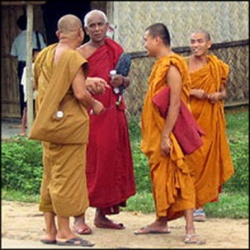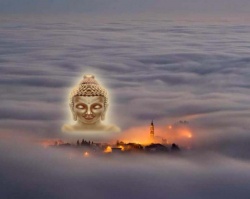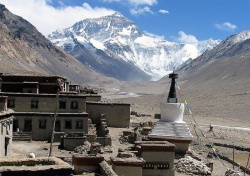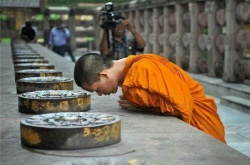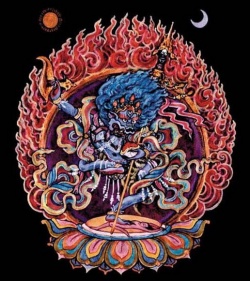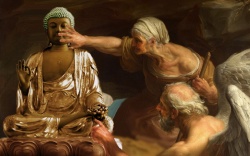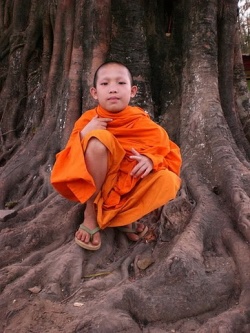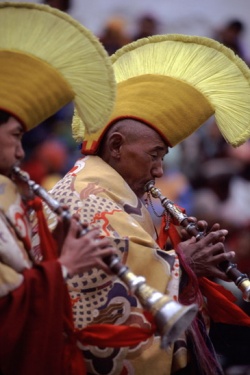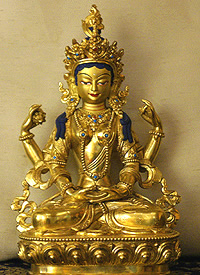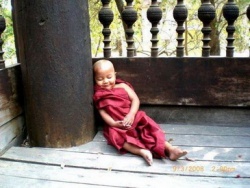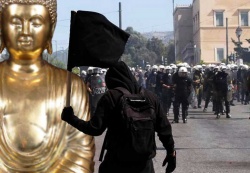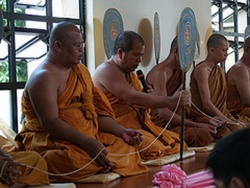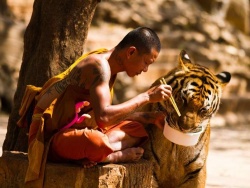Barom Tarma Wangchug
Barom Dharma Wangchug (1127 – 1199) was born in the area called Gawa Yulna in Penyul.
The forefathers in his clan of Dakarwa were one of the seven Tibetans who first took monastic vows and some ministers of the early Tibetan dharma kings.
His father was Donba Jungne Lodro and his mother Jomo Lochungma.
They had three sons, among whom he was the middle one, named Bumgyab.
At the age of seven, he took monastic ordination from the preceptor Bogawa Tarma and the instructor Wangchug Shonnu, receiving the name Dharma Wangchug.
Thereafter, he studied the Kadampa teachings with the famous Trolungba Lodro Jungne (eleventh – twelfth century), the great disciple of Ngog Lotsawa (1059 – 1109), Geshe Botowa (1031? – 1105), and Geshe Jayulwa (1075 – 1138).
At the age of twenty, encouraged by a yogin and out of devotion for Gampopa that had already developed in him before through merely having heard this master’s name, he went to Gampopa’s seat.
During a ceremony of the tenth day of the month, he saw Gampopa directly as Vajradhara and stayed with him as his untiring attendant for six years.
He received the entire transmission of the Kagyu lineage and realisation dawned in him simultaneously without difficulty.
In particular, he trained in the practice of illusory body throughout day and night.
Finally, in 1153, Gampopa told him to go to Barom and practice there, since it is a place blessed by many great masters, such as Marpa Lotsawa (1012 – 1097).
However, Dharma Wangchug fervently requested Gampopa to allow him to stay with him until he would pass away.
Gampopa said, “Barom, do so, if you please. Let’s stay together for another thirty-three days as father and son.”
After these thirty-three days, Gampopa passed away.
Although many, such as Gampopa’s nephew and disciple Gomtsul (1116 – 1169), advised him to stay at Gampo, he followed the words of Gampopa and went north to Barom.
From 1154 onward, he stayed in solitary retreat there at Dza Telu Rinchenbung for seven years.
He mostly sustained himself through the power of his meditative concentration.
During these years, he sang twenty-nine cycles of great dohas, such as his supplication to the Kagyu gurus.
Thereafter, he travelled to Kham and was supported by the great official Yeshe Sal.
He stayed in Gyotu Tragar for three years where he instructed numberless disciples, with many geshes gathering around him.
All in all, he went to Kham three times and founded the monasteries of Gotso and Lode.
In 1176, he went on to Chipar Lhakang, where the sponsor Tartrawa offered him his sons, horses and so on.
Dharma Wangchug placed his hands on the head of one of these young boys, who sat at the family’s nomad tent, and said,
“I give you empowerment through OM AH HUM.
You will become a siddhi who benefits sentient beings”.
Later, the boy became his main disciple, Tishri Repa (1164 – 1236).
Eventually, he returned to Barom and built a temple and a monastery there at one side of Red Rock.
He displayed innumerable signs of having attained siddhis and gave dharma advice to many students.
He also had a meeting with the founder of the Dalung Kagyu School, Dalung Tangpa Dashi Bal (1142 – 1210), who had arrived on a river nearby.
In 1198, he met Jigden Sumgon (1143 – 1217), the founder of the Drikung School, as the latter was on his way to Namra.
He received some instructions on bodhicitta and Mahamudra from Jigden Sumgon and, in return, payed perfect homage and service to him, such as offering his own disciples.
Finally, at the age of seventy-two, he passed away by displaying many miraculous signs.
In general, Baromba Dharma Wangchug guided many disciples through unifying the Mahamudra of the basic nature and the Mahamudra of bliss-emptiness in sutra and tantra.
In this way, he became the founder of the Barom Kagyu lineage, whose teachings were widely propagated (mainly by Tishri Repa), thus becoming one of the four greater Kagyu lineages.
Among his many disciples, the foremost were “the four great sons” such as Dsetrom Wangchug Senge, “the four close ones” such as Traga Lhadon, and “the five sons who held his lineage” such as Tishri Repa.
The latter eventually became the guru of the then Chinese emperor (“tishri” means imperial preceptor) and demonstrated many miraculous feats at the court.
He was followed – in both roles as the supreme head of the Barom lineage and the imperial guru – by Repa Garbo, who was even more accomplished than Tishri Repa.
After him came Tsangsar Lume Dorje, who was enthroned by the then Central Tibetan king Chogyal Pagba as both the head of the Barom lineage and the local ruler of Tsangsar in the province of Nangchen in eastern Tibet.
Both positions were continued by Jangchub Shonnu and his successors.
The Barom monastery continued to be headed for several generations by members of his family lineage in a transmission from uncle to nephew.
A Song About The Few
By Barom Dharma Wangchug
There are few people who act with devotion and respect,
For the guru who is inseparable from the three kayas.
There are few people who pay heed,
To the advice of the kind guru.
There are few people who keep,
The threefold samaya vows.
There are few people who put into practice,
The instructions that are the heart-essence of the (guru’s) mind.
There are few people who make efforts,
In their spontaneously present inner heat.
There are few people who gain mastery,
Over the “meditative concentration of the sky treasure.
There are few people who seriously engage,
In subtle and true actions and their results.
There are few people who cast away everything,
And practice for sentient beings.
There are few people who cultivate a mind of loving care,
For their late mothers, the sentient beings in the six migrations.
There are few people who realise,
That cyclic existence has the nature of suffering.
There are few people who have no bias,
With regard to the view, unchanging emptiness.
There are few people whose mind is nonreferential,
In meditation, unbound luminosity.
There are few people who have no pretense,
With regard to conduct, the equality of even taste.
There are few people who are without clinging,
To their experiences, this diversity arising from conditions.
There are few people who have neither hope nor fear,
With regard to the spontaneously present fruition.
There are few people who mentally disengage,
When it comes to the ultimate beyond mind.
There are few people who have no dualistic clinging,
To the nonduality of appearances and the mind free from reference points.
There are few people who are not distracted,
From uncontrived ordinary mind.
There are few people who are not attached,
To single-flavoured, undefiled bliss-emptiness.
There are few people who are not tainted,
With regard to naked awareness that is not a thing.
There are few people who unite,
The two streams of means and prajna.
There are few people who become weary,
Of this plethora of activities that can never be finished.
There are few people who understand,
That the seeming reflections of their latent tendencies are illusions.
There are few people who realise,
Unborn mind itself as just that.
There are few people who join meditative-equipoise and life in-between,
Within the unimpeded essence.
There are few people in whom these various random thoughts,
Are liberated in their own place.
There are few people in whom this thought-free, unborn nature,
Dawns as the dharmakaya.
There are few people for whom this illusory body, the mandala of the Victors,
Shines as sambhogakaya.
There are few people who realise,
This great emptiness-compassion as the nirmanakaya.
